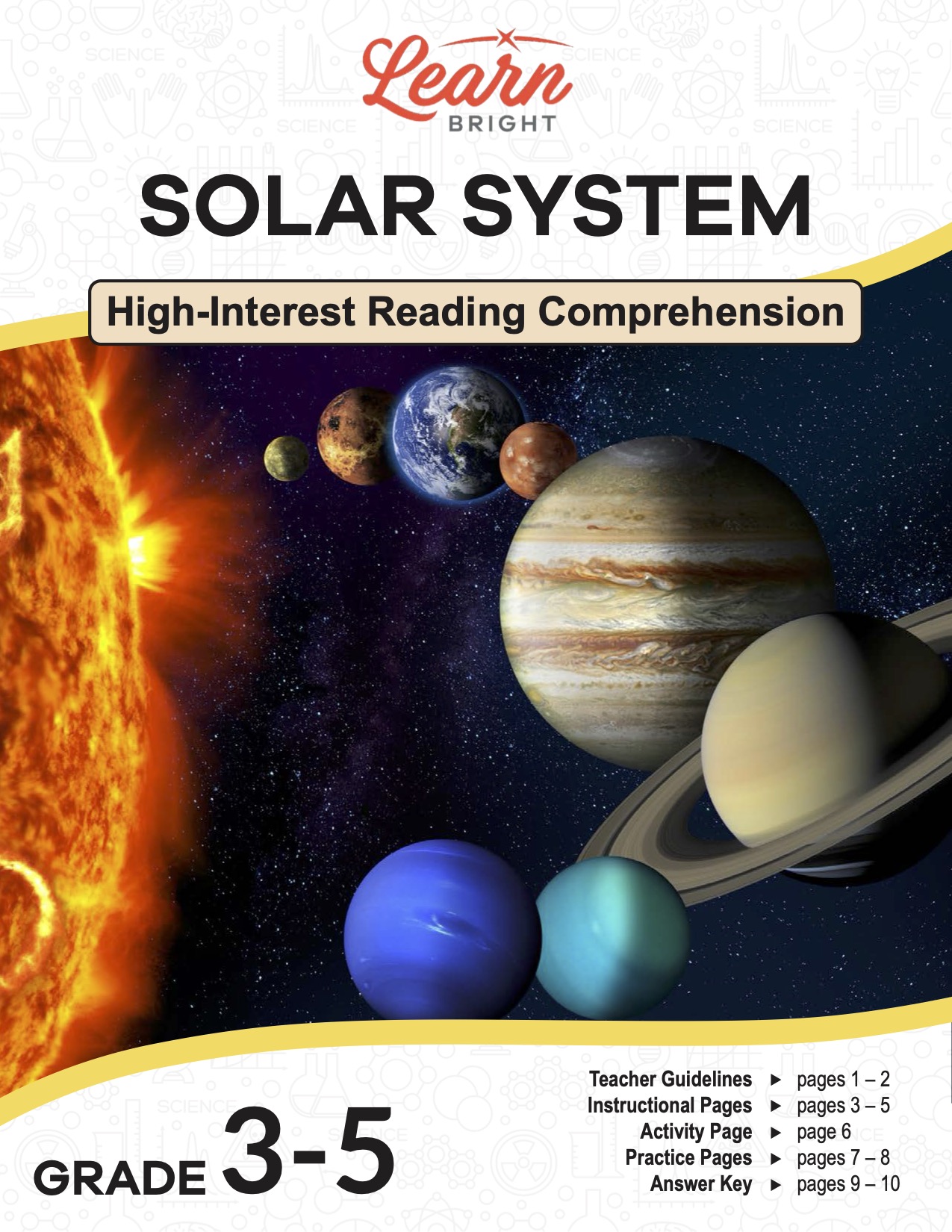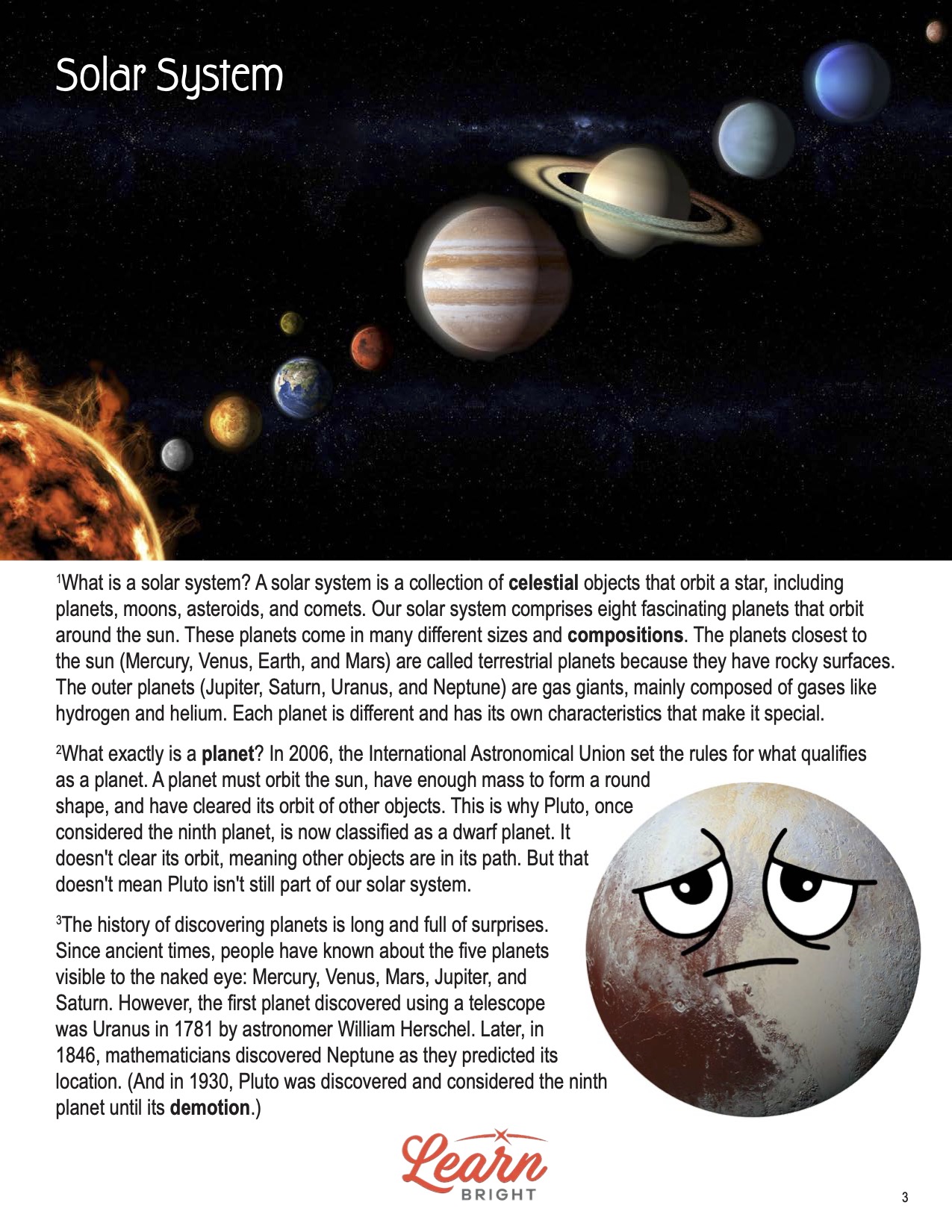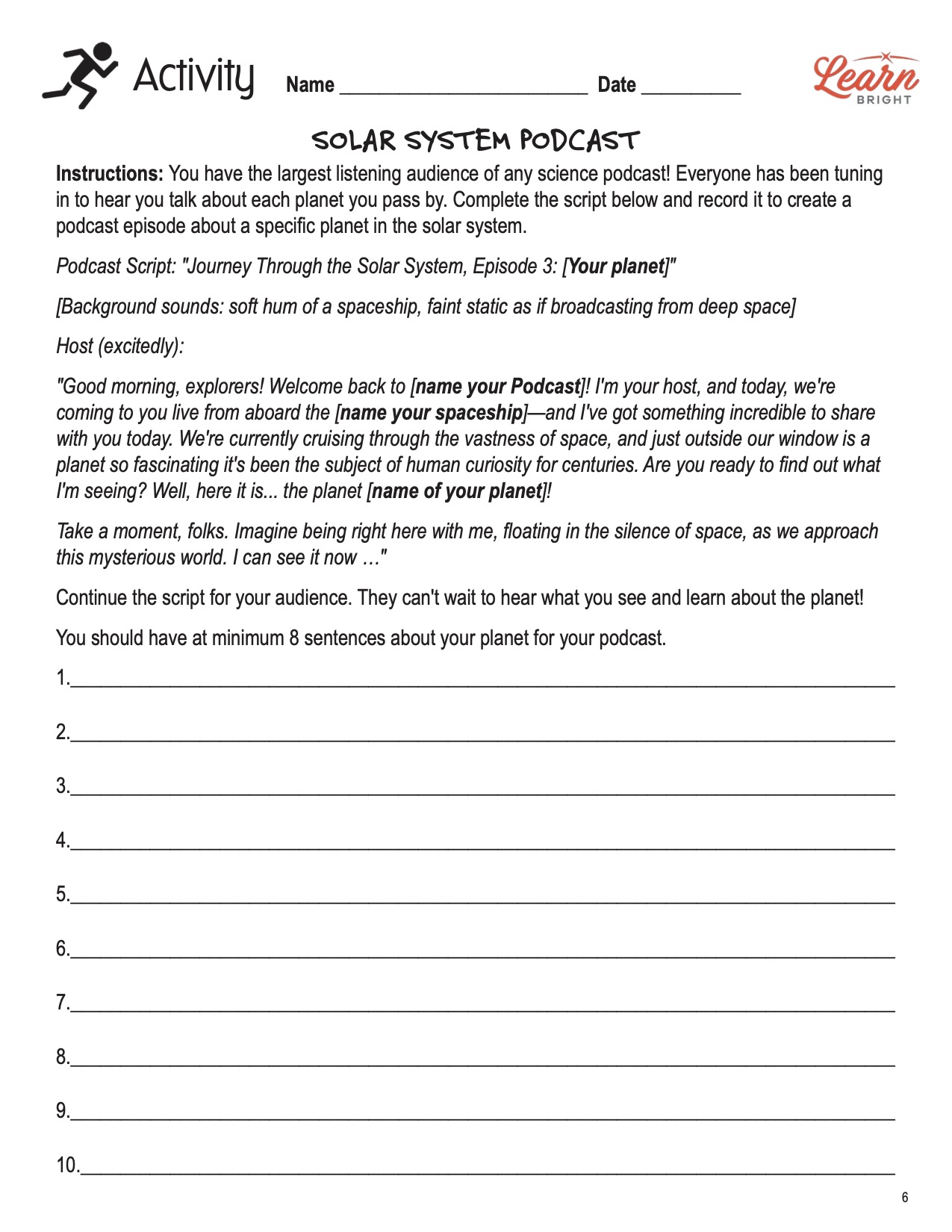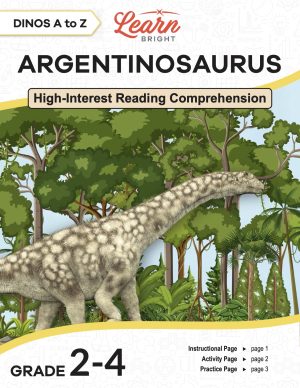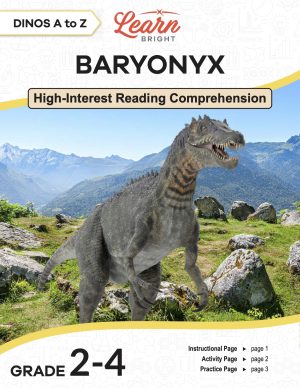Description
What our Solar System lesson plan includes
Lesson Objectives and Overview: Solar System is a high-interest reading comprehension lesson plan. As such, students will practice various close reading and comprehension skills. In addition, they will will determine the central idea or theme and understand more about various components of the solar system. This lesson is for students in 3rd grade, 4th grade, and 5th grade.
Classroom Procedure
Every lesson plan provides you with a classroom procedure page that outlines a step-by-step guide to follow. You do not have to follow the guide exactly. The guide helps you organize the lesson and details when to hand out worksheets. It also lists information in the yellow box that you might find useful. You will find the lesson objectives, state standards, and number of class sessions the lesson should take to complete in this area. In addition, it describes the supplies you will need as well as what and how you need to prepare beforehand. The activity requires a number of supplies, including CDs, foam balls, and paperclips. You may want to cut the foam balls in half ahead of time.
Teacher Notes
The teacher notes page provides an extra paragraph of information to help guide the lesson and remind you what to focus on. It explains that you can teach this lesson in a whole-class setting or as an independent, small-group activity. The blank lines on this page are available for you to write out thoughts and ideas you have as you prepare the lesson.
SOLAR SYSTEM LESSON PLAN CONTENT PAGES
Introduction
The Solar System lesson plan has three pages of content. What is a solar system? A solar system is a collection of celestial objects that orbit a star, including
planets, moons, asteroids, and comets. Our solar system comprises eight fascinating planets that orbit around the sun. These planets come in many different sizes and compositions. The planets closest to the sun (Mercury, Venus, Earth, and Mars) are called terrestrial planets because they have rocky surfaces. The outer planets (Jupiter, Saturn, Uranus, and Neptune) are gas giants, mainly composed of gases like hydrogen and helium. Each planet is different and has its own characteristics that make it special.
What exactly is a planet? In 2006, the International Astronomical Union set the rules for what qualifies as a planet. A planet must orbit the sun, have enough mass to form a round shape, and have cleared its orbit of other objects. This is why Pluto, once considered the ninth planet, is now classified as a dwarf planet. It doesn’t clear its orbit, meaning other objects are in its path. But that doesn’t mean Pluto isn’t still part of our solar system.
Discovery of Planets
The history of discovering planets is long and full of surprises. Since ancient times, people have known about the five planets visible to the naked eye: Mercury, Venus, Mars, Jupiter, and Saturn. However, the first planet discovered using a telescope was Uranus in 1781 by astronomer William Herschel. Later, in 1846, mathematicians discovered Neptune as they predicted its location. (And in 1930, Pluto was discovered and considered the ninth planet until its demotion.)
Each planet is fascinating for different reasons. For example, Venus is the hottest planet in our solar system. Its surface temperatures are hot enough to melt lead. Jupiter is the largest planet, home to a giant storm called the Great Red Spot, which has been raging for over 400 years! And Saturn’s rings are made of ice and rock. They are so broad that they could stretch from Earth to the moon.
The planets in our solar system are arranged in a specific way, with the smaller, rocky planets near the sun and the larger gas giants farther away. This arrangement exists due to the way the solar system formed. The sun’s gravity pulled most of the gas and dust toward the center, forming the sun. At the same time, the remaining materials created the planets. The inner planets are smaller because the sun’s heat causes lighter materials to evaporate, leaving only the heavier metals and rocks behind.
Moons and Atmosphere in the Solar System
Some planets have a moon or many moons, while others don’t. Jupiter has 95 moons and Saturn has 146. Earth has one moon, which is essential for our planet’s tides. Mars has two small moons that scientists think are captured asteroids. Mercury and Venus don’t have any moons, though. They are the only planets in our solar system without moons. The planets with moons have interesting systems in place that affect the planets’ motion and stability.
Every planet’s atmosphere, which is made up of different gases, is also unique. For instance, Earth’s atmosphere is mostly nitrogen and oxygen, which makes it perfect for supporting life. Venus, however, has a thick, dense atmosphere that consists mostly of carbon dioxide, trapping heat and making it the hottest planet in the solar system. Jupiter’s atmosphere is mostly hydrogen and helium, with colorful clouds of ammonia and methane mixed in. The different compositions of each planet’s atmosphere are influenced by its distance from the sun, it size, and its gravity, which determines how much of each gas it can hold onto.
One of the most fascinating things about our own planet and its position in the solar system is how it affects life. Earth’s placement in the solar system allows it to have liquid water, which is essential for life. The distance from the sun provides just the right amount of heat for living things to thrive. This perfect balance is something that scientists believe may be rare in the universe.
Other Celestial Objects
In addition to the planets, our solar system has many other fascinating objects like asteroids and comets. Asteroids are small, rocky bodies that orbit the sun, primarily found in the asteroid belt between Mars and Jupiter. Comets are icy objects that develop tails of gas and dust when they get close to the sun. These objects are important because they are like leftover building blocks from the early solar system. And, while you may be able to see many stars at night, these are far outside our solar system! We have only one star, the sun, in our solar system. The stars you see are part of the larger Milky Way, the name of our galaxy.
Understanding celestial bodies in our solar system helps us learn more about our own planet and how it works in the vastness of the universe. As a rocket zooms through space—whoosh—it reminds us how exciting space exploration can be. By studying other objects in space, scientists can discover more about the history of our solar system and even search for signs of life on planets in distant solar systems. The study of our solar system is just beginning and ever-evolving, and there is much more to discover!
SOLAR SYSTEM LESSON PLAN WORKSHEETS
The Solar System lesson plan includes two worksheets: an activity worksheet and a practice worksheet. Each one will help students solidify their grasp of the material they learned throughout the lesson. You can refer to the classroom procedure guidelines to know when to hand out each worksheet.
SOLAR SYSTEM PODCAST ACTIVITY WORKSHEET
For this activity, students will pretend that they are the host of a podcast. They will choose one of the planets to research and talk about during a special episode. The worksheet provides a beginning script, followed by 10 lines that students can fill in with facts about the planet they chose. After the finish writing out the rest of the episode, they will record it to show the rest of the class!
REVIEW PRACTICE WORKSHEET
The practice worksheet lists 10 questions based on the content. These questions all relate to the content pages, so students will need to refer to them often for the answers. In addition, each question provides which reading tool the question corresponds to, such as text feature, vocabulary, or comprehension.
Worksheet Answer Keys
At the end of the lesson plan document is an answer key for the practice worksheet. The correct answers are all in red to make it easier for you to compare them with students’ responses. If you choose to administer the lesson pages to your students via PDF, you will need to save a new file that omits these pages. Otherwise, you can simply print out the applicable pages and keep these as reference for yourself when grading assignments.

